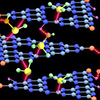| Jul 05, 2023 |
|
(Nanowerk News) The utilization of photoluminescent substances within the realm of information security has increasingly garnered interest. A range of anti-counterfeiting modalities, inclusive of watermarks, two-dimensional codes, and luminescent printing, have been innovatively developed. Nonetheless, the prevalent usage of monochromatic fluorescent materials has presented a considerable challenge due to their susceptibility to counterfeiting.
|
|
An ensemble of researchers from the Suzhou Institute of Biomedical Engineering and Technology (SIBET), associated with the Chinese Academy of Sciences, has pioneered the development of a multicolored afterglow nanocomposite material. This feat was achieved via a straightforward hydrothermal technique, employing silane as the phosphorescent material’s precursor for the synthesis of silicon-based compounds, subsequently finding application in the field of information security.
|
|
The investigative findings were disclosed in the Chemical Engineering Journal (“Multi-Color Room temperature phosphorescent Silicon-Nanodot-Based nanocomposites with silane tuning and applications to 5D information encryption”).
|
 |
| Schematic illustration for the preparations of [email protected], [email protected], [email protected], and [email protected] (Image: SIBET) (click on image to enlarge)
|
|
Materials demonstrating room-temperature phosphorescence (RTP) have found diverse applications in bioimaging, information security, and lighting, primarily attributed to their unique afterglow characteristics.
|
|
The lead investigator, DONG Wenfei, noted that traditional synthesis methodologies predominantly utilize inorganic compounds bearing rare earth ions or noble metal complexes to achieve afterglow. This approach, however, invariably incurs substantial biological toxicity and costly synthesis processes.
|
|
As DONG elaborated, two conditions are integral to successful synthesis: effective exciplex intersystem crossing and a structurally rigid framework that ensures the excited triplet states of the exciplexes remain stable.
|
|
With these considerations in mind, the researchers chose 3-Aminopropyl triethoxysilane (APTES) and N-[3-(Trimethoxysilyl) propyl] ethylenediamine (DAMO) as silicon sources, incorporating urea as an additional precursor. This selection led to the creation of optically stable cyan and yellow RTP materials, respectively.
|
|
The fabrication process employed a single-step hydrothermal technique, which not only effectively circumvents the drawbacks associated with two-step methods but also conveniently yields in-situ nanodots and embeds them within the matrix.
|
|
The resulting anti-counterfeiting strategy holds promise for sophisticated encryption scenarios. Here, only interference information can be acquired in ultraviolet-irradiation and afterglow modes. Thus, a filter becomes necessary for accurately deciphering the encrypted content, thereby providing superior concealment of the correct information.
|
|
Dr. ZAN Minghui, the corresponding author of the study, noted the extensive applicability of their approach. This standardized methodology underscores the potential of silane in constructing multifunctional phosphorescent materials, offering a fresh design principle for synthesizing full-color afterglow materials.
|
|
Ultimately, this study underlines the viability of silane as a means of creating multi-color phosphorescent materials. It also offers innovative design principles and insights for crafting silicon-based afterglow materials for pioneering applications.
|


